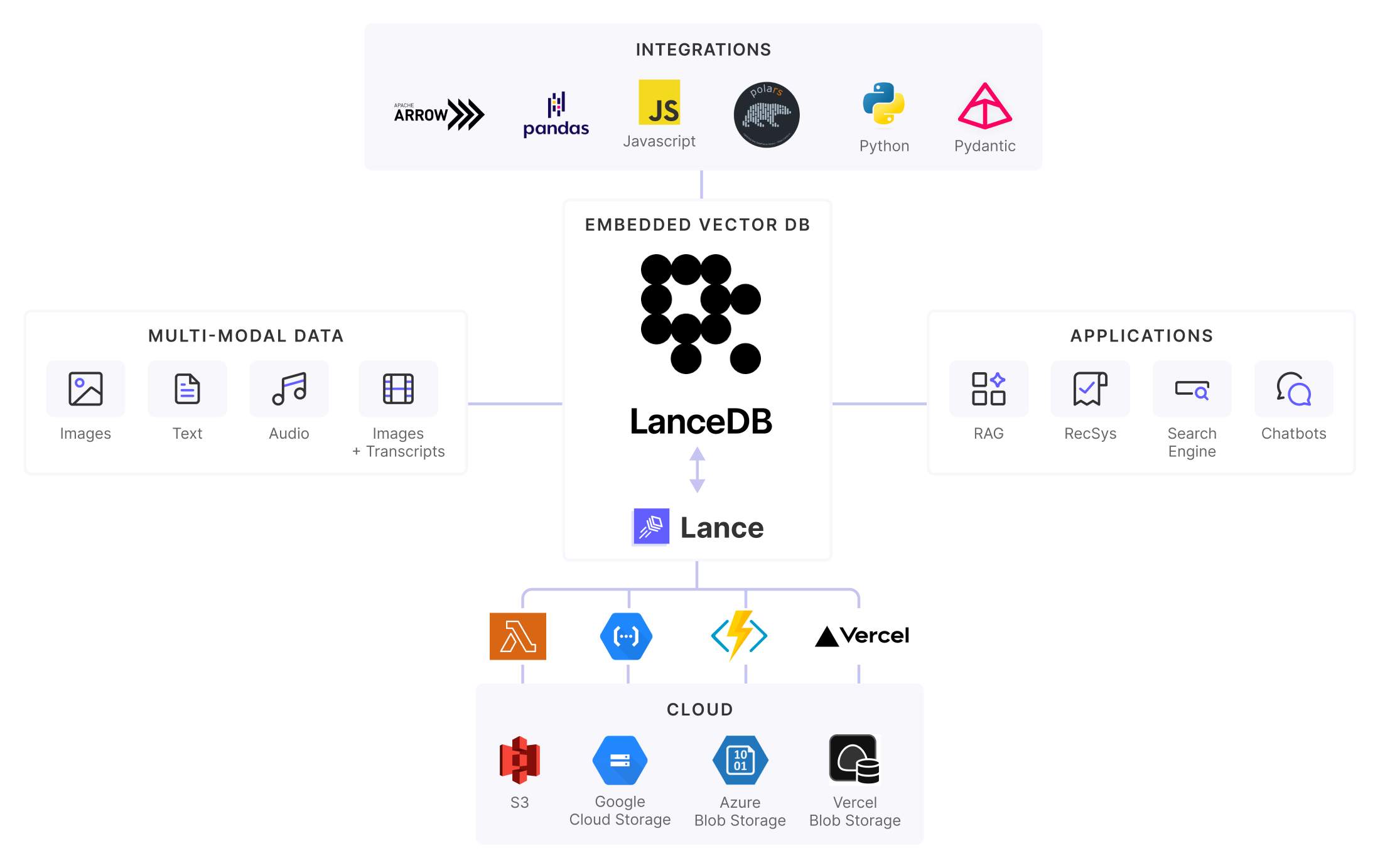LanceDB
LanceDB is an open-source vector database for AI that's designed to store, manage, query and retrieve embeddings on large-scale multi-modal data. The core of LanceDB is written in Rust 🦀 and is built on top of Lance, an open-source columnar data format designed for performant ML workloads and fast random access.
Both the database and the underlying data format are designed from the ground up to be easy-to-use, scalable and cost-effective.
Hosted LanceDB
If you want S3 cost-efficiency and local performance via a simple serverless API, checkout LanceDB Cloud. For private deployments, high performance at extreme scale, or if you have strict security requirements, talk to us about LanceDB Enterprise. Learn more

Truly multi-modal
Most existing vector databases that store and query just the embeddings and their metadata. The actual data is stored elsewhere, requiring you to manage their storage and versioning separately.
LanceDB supports storage of the actual data itself, alongside the embeddings and metadata. You can persist your images, videos, text documents, audio files and more in the Lance format, which provides automatic data versioning and blazing fast retrievals and filtering via LanceDB.
Open-source and cloud solutions
LanceDB is available in two flavors: OSS and Cloud.
LanceDB OSS is an open-source, batteries-included embedded vector database that you can run on your own infrastructure. "Embedded" means that it runs in-process, making it incredibly simple to self-host your own AI retrieval workflows for RAG and more. No servers, no hassle.
LanceDB Cloud is a SaaS (software-as-a-service) solution that runs serverless in the cloud, making the storage clearly separated from compute. It's designed to be cost-effective and highly scalable without breaking the bank. LanceDB Cloud is currently in private beta with general availability coming soon, but you can apply for early access with the private beta release by signing up below.
Try out LanceDB Cloud (Public Beta) Now
Why use LanceDB?
-
Embedded (OSS) and serverless (Cloud) - no need to manage servers
-
Fast production-scale vector similarity, full-text & hybrid search and a SQL query interface (via DataFusion)
-
Python, Javascript/Typescript, and Rust support
-
Store, query & manage multi-modal data (text, images, videos, point clouds, etc.), not just the embeddings and metadata
-
Tight integration with the Arrow ecosystem, allowing true zero-copy access in shared memory with SIMD and GPU acceleration
-
Automatic data versioning to manage versions of your data without needing extra infrastructure
-
Disk-based index & storage, allowing for massive scalability without breaking the bank
-
Ingest your favorite data formats directly, like pandas DataFrames, Pydantic objects, Polars (coming soon), and more
Documentation guide
The following pages go deeper into the internal of LanceDB and how to use it.
- Quick start: Get started with LanceDB and vector DB concepts
- Vector search concepts: Understand the basics of vector search
- Working with tables: Learn how to work with tables and their associated functions
- Indexing: Understand how to create indexes
- Vector search: Learn how to perform vector similarity search
- Full-text search (native): Learn how to perform full-text search
- Full-text search (tantivy-based): Learn how to perform full-text search using Tantivy
- Managing embeddings: Managing embeddings and the embedding functions API in LanceDB
- Ecosystem Integrations: Integrate LanceDB with other tools in the data ecosystem
- Python API Reference: Python OSS and Cloud API references
- JavaScript API Reference: JavaScript OSS and Cloud API references
- Rust API Reference: Rust API reference